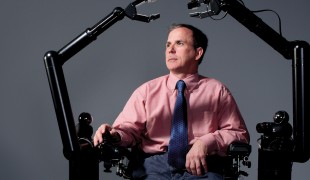- 3670
- 359
- 3
- 4
- 0
- Help Ukraine
About the solution
"There was no option, I had to get out of there and work. I had the responsibility to go forward for everything my family did for me, as they never left me. In the hospital they told me that now the state would protect me, through help for people with disabilities. But I refused to conform".
Rafael started drawing, and with help from his uncle Brunell Rodríguez and Ortopedia Caracas, he made the first prototype. "My uncle showed me prosthetics that I did not know existed and with my knowledge of electronics that for the moment was very basic, I managed to make a small design that he did and at home, I opened a world of possibilities unimaginable".
The prosthetic arm, until completely finished, detects the myoelectric signals of the muscles and transforms them into electronic commands that give movement to different joints.
The device is not particularly refined. It has a piece in the prosthetic that helps the cellular technician to hold the items he needs to repair; a magnifying glass with a light designed to let Rafael see more closely those pieces and parts of a circuit; and a series of sensors near his collarbone that respond to the circular motions of his body and allow even greater mobility and precision. "In a hospital bed you have too much time to think,” the inventor explained. “Here, I devised a way to live and return to work.”
The model he designed earned him the National Prize for Invention Technological Popular "Luis Zambrano" 2014 with the prototype of a robotic arm disarticulated shoulder.
Adapted from: http://bit.ly/2rYn1Kq
https://youtu.be/suFdOkCQWZo
This solution shall not include mention to the use of drugs, chemicals or biologicals (including food); invasive devices; offensive, commercial or inherently dangerous content. This solution was not medically validated. Proceed with caution! If you have any doubts, please consult with a health professional.
DISCLAIMER: This story was written by someone who is not the author of the solution, therefore please be advised that, although it was written with the utmost respect for the innovation and the innovator, there can be some incorrect statements. If you find any errors please contact the patient Innovation team via info@patient-innovation.com
-
-
286
-
0
-
3322

Teacher Alex Truesdell is Transforming Lives: Adaptive Design Association Revolutionizes Disability Solutions
CAREGIVING
Drawing
Painting
Playing
BODY BALANCE: Maintaining body balance
(SELF)-CARE: DRINKING: Drinking independently.
(SELF)-CARE: EATING: Eating independently.
MOVING IN A WHEELCHAIR: Moving using a wheelchair.
Playing an instrument
Studying
Blindness
Hand Deformity
Neuromuscular Disorders
Assistive Daily Life Device (to help ADL)
Walking Aid (wheelchair/walker/crutches)
Restoring mobility
Replacing lost limbs
Enhancing health literacy
Promoting self-management
Promoting inclusivity and social integration
To improve Treatment/Therapy
Preventing (Vaccination, Protection, Falls, Research/Mapping)
Raise awareness
Caregiving Support
General and Family Medicine
Internal Medicine
Orthopedics
Pediatrics
Physical Medicine and Rehabilitation
United States
-
-
-
449
-
0
-
7246

Paralyzed man designs innovative wheelchairs
CAREGIVING
MOVING IN A WHEELCHAIR: Moving using a wheelchair.
Grip
Rubgy
Basketball
Paralysis
Cervical spinal cord injury/Tetraplegia
Assistive Daily Life Device (to help ADL)
Assistive Technology access
Walking Aid (wheelchair/walker/crutches)
Restoring mobility
Replacing lost limbs
Promoting self-management
Promoting inclusivity and social integration
Recovering from Traumatic Injuries
Preventing (Vaccination, Protection, Falls, Research/Mapping)
Caregiving Support
Neurology
Orthopedics
Physical Medicine and Rehabilitation
United States
-
-
-
723
-
0
-
10883

Azai Bionic Arm
-
 en
en